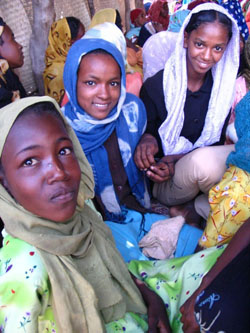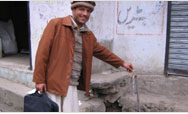You are here » Home » Telling Our Story
Success Story
Community-based health education initiatives improve local capacity
Training Midwives in Darfur

| |
Photo: ARC
|
|
Girls in the El Tomat II camp for displaced people attend health education classes.
Head midwives working in the USAID program are highly respected throughout South Darfur. Midwife and health education initiatives have benefited an estimated 191,100 displaced people.
|
Between January and March 2006, USAID supported the training of nearly 100 midwives in camps between Nyala and Gereida in South Darfur. Communities there have welcomed the initiative, and the program’s head midwives are highly respected throughout the region. With this training, the midwives will be able to provide improved prenatal counseling and health services both in camps for displaced people and in their host communities. In addition, nearly 1,000 other area residents, including 639 women and girls, attended USAID-supported general health education classes that covered a range of topics, including hygiene, safe water and sanitation practices, nutrition, diarrhea, sexual and gender-based violence, and HIV/AIDS.
USAID’s midwife training program seeks to ensure that local health workers will continue to serve their communities over the long term. The midwives receive one year of training during which they learn principles of maternal and child health, including proper nutrition and breastfeeding. They also learn to set up efficient delivery rooms, correctly use midwifery equipment, and recognize and refer rape victims for emergency medical, legal, and counseling services. After the program, continued supervisory visits, on-the-job training, and workshops reinforce the training and promote a higher standard of health care.
Sumaia enrolled in the program to earn income to support her family and graduated in 2005. Now, she can work as a midwife in her own village rather than migrating to a city in search of employment. As a program graduate, Sumaia recognizes the limited capacity of reproductive health services in South Darfur and says she is proud to contribute to improving her community’s health.
Since the start of the Darfur conflict in 2003, USAID has been a leader in the massive international assistance program, providing extensive humanitarian and food aid throughout the region. USAID provides assistance to all of the approximately 200 camps in Darfur, which shelter more than 1.8 million people who have been driven from their homes.
Print-friendly version of this page (470kb - PDF)
Click here for high-res photo
Back to Top ^ | 

